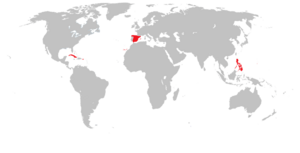Sexenio Democrático facts for kids

The Sexenio Democrático or Sexenio Revolucionario means the "Six Years of Democracy" or "Revolutionary Six Years." This was a special time in the history of Spain that lasted for six years, from 1868 to 1874.
This period began on September 30, 1868. That's when Queen Isabella II of Spain was removed from power after a big event called the Glorious Revolution. The Sexenio Democrático ended on December 29, 1874. At that time, Alfonso XII, who was Isabella's son, became King. This happened after a military takeover led by Arsenio Martínez-Campos.
During these six years, Spain created a very important document: the 1869 Constitution. This constitution was one of the most modern for its time. It focused a lot on the rights of Spanish citizens.
The Sexenio Democrático had three main parts:
- The Provisional Government (1868–1871) of the Kingdom of Spain (September 1868 – January 1871)
- The time when King Amadeo I of Spain ruled the Kingdom of Spain (January 1871 – February 1873)
- The First Spanish Republic (February 1873 – December 1874)
Overall, the Sexenio Democrático was a very unstable time for Spanish politics. There were many changes in government and leadership.
Contents
The Six Years of Change in Spain
The Sexenio Democrático was a period of big changes in Spain. Before this time, Spain was ruled by a queen. But many people wanted more freedom and a different way of governing. This led to a revolution and a new era for the country.
What Happened?
The main goal of this period was to bring more democracy and modern ideas to Spain. People wanted to have more say in how their country was run. They also wanted to make sure everyone had more rights.
The Start: Overthrowing the Queen
The Sexenio Democrático began with the Glorious Revolution in 1868. This was a movement by people who were unhappy with Queen Isabella II. They believed she was not a good ruler and wanted her to leave the throne. The revolution was successful, and Queen Isabella II was forced to leave Spain. This opened the door for new types of government.
A New Constitution
After the Queen left, Spain needed new rules. So, in 1869, a new constitution was written. A constitution is like a rulebook for a country. The 1869 Constitution was special because it gave many rights to Spanish citizens. It talked about things like freedom of speech and the right to vote for men. It was one of the most advanced constitutions in Europe at that time.
Key Periods of the Sexenio
The six years were divided into three main parts, each with its own challenges and leaders.
The Provisional Government
After the revolution, Spain was run by a "Provisional Government." This means it was a temporary government. It lasted from September 1868 to January 1871. During this time, leaders tried to decide what kind of government Spain should have next. They also worked on the new 1869 Constitution. They looked for a new king for Spain.
King Amadeo I's Reign
In January 1871, a new king was chosen: Amadeo I of Spain. He was not from Spain, but from Italy. He tried his best to rule Spain fairly. However, he faced many problems. Different political groups in Spain disagreed a lot. King Amadeo I found it very difficult to unite the country. Because of these challenges, he decided to give up his throne in February 1873.
The First Spanish Republic
After King Amadeo I left, Spain became a "Republic." This meant it no longer had a king or queen. Instead, the country was governed by elected leaders. This was called the First Spanish Republic. It lasted from February 1873 to December 1874. This was a very short and difficult time. There were many different ideas about how the Republic should work, and leaders changed very often.
Why Was It Unstable?
The Sexenio Democrático was a very unstable time. This means there were many changes in government and a lot of political fighting.
- Many different ideas: People had very different ideas about how Spain should be run. Some wanted a king, others wanted a republic, and even within those groups, there were many disagreements.
- Quick changes: Governments changed very quickly, and leaders didn't stay in power for long. This made it hard to make lasting decisions.
- Military involvement: The military often played a role in politics, sometimes taking control or supporting certain groups.
The period ended with another military takeover, which brought back the monarchy. This time, Alfonso XII, the son of Queen Isabella II, became the new King of Spain. This event is known as the Bourbon Restoration.
See also
 In Spanish: Sexenio Democrático para niños
In Spanish: Sexenio Democrático para niños
Images for kids


